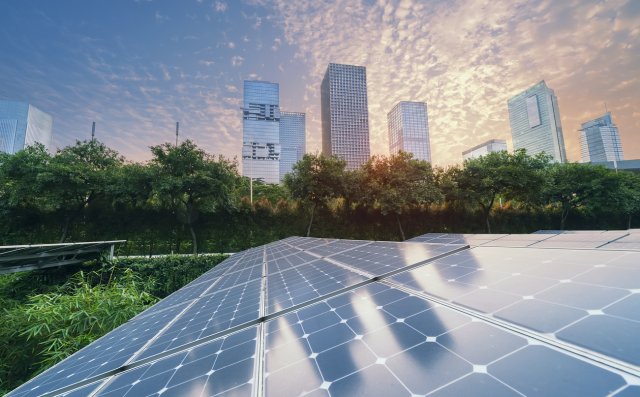The influence of sustainability across every industry can’t be understated, as micro and macro strategies are increasingly ingrained into everyday living, working, and recreational experiences. From influencing personal choices to driving large-scale business and economic decisions, more public and private organizations are embracing their leadership roles on the issue of ecological stewardship. Rather than giving into resignation in the face of heightening stakes and urgency, inspiring leaders are focusing on what can yet be achieved. The real estate and development communities are no exception and, for their part, built environment leaders are largely and aggressively pursuing practices and strategies to plan, construct, and manage assets more efficiently and more resiliently.
As one of the largest industries in the world, the impact can be huge. According to ULI’s 2021 Sustainability Outlook, “[t]he buildings sector currently contributes nearly 40 percent of carbon emissions globally and nearly 70 percent of emissions in urban areas. This raises the opportunity for the industry to advance sustainability at the portfolio level
and also through partnerships with local policymakers.” In other words, the industry overall has the potential to be the change driver.
From LEED and WELL certification to net zero goals, circular economy practices, and local ecological preservation, project and asset lifecycles are being defined and judged by their ability to deliver appreciable sustainability gains. Financial activity, including across private and publicly traded funds and securities, are showing that ESG strategy is increasingly important for investors, many of whom have mandates to allocate capital to assets and firms that commit to sustainability results. Still, a 2021 sustainability report from RICS shows that while that enthusiasm for green investing is growing significantly, there is work to be done.
But the trend is encouraging—and more and more firms have the foresight to see that resilience and mitigating the effects of climate change is good for business in both the long and short terms, even if there are immediate pain points to modernizing building and management practices.
Here are just a few examples of how that’s manifesting in inspiring ways:
High Goals for NYC High Rises
NYSERDA has begun a $50 million fund aimed at driving business growth through sustainable, low-carbon urban renewal. The first round of grant recipients for this Empire Building Challenge includes a cross-section of some of the city’s most impactful projects from some of its most innovative owners, including Empire State Realty Trust’s Empire State Building, L+M’s The Heritage, Omni New York’s Whitney Young Manor, and Hudson Square Properties’ 345 Hudson.
The goal of the EBC is to “spur economic growth and renewal in New York by attracting best-in-class manufacturers, solution providers, and entrepreneurs from around the world to help transform our existing building stock into the buildings of the future.” These projects will provide decarbonization insights and serve as examples for how to achieve green retrofitting in large buildings efficiently and feasibly. This can be a major step in achieving the OneNYC goal of making New York the world’s most progressive major city for climate resilience.
A Collaborative Urban Approach in Singapore
Singapore has long stood as a leader in design-forward urban planning and building development. Using 2020 as a starting point, the nation’s Green Plan 2030 uses the UN’s 2030 Sustainable Development Agenda and the Paris Agreement as a framework to achieve ambitious and—importantly—concrete net zero targets over the succeeding decade. The plan touches all aspects of the country’s life, from retail and food and beverage to coastal sustainability and flood resilience, among many more.
The plan takes a collaborative approach between development, infrastructure, and land use stakeholders, while the changes adopted require both individual and institutional buy-in. For example, buildings will cease using high-global warming refrigerants by the end of 2022, while the large-scale rollout of solar panels across Singapore will power 350,000 homes by 2030. On construction projects, Singapore is embracing the circular economy through the use of NEWSand, a material developed from waste treatment residue, for a range of assets, from roads and pathways to built structures.
Positive Energy in Norway
Powerhouse Brattørkaia has the distinction of being not only net zero but energy-positive, the largest of its kind in Norway at nearly 60,000 square feet. Developed and owned by Entra, designed by Snøhetta, and built by Skanska, the project was completed in 2019 and recently featured at COP26. Remarkably, the office building, designed to be insulated against harsh winters and warm summers, incorporates renewable sources of energy such as solar to produce more energy than the total consumed in the construction process, including the production of its materials. Going even further across the operations of the finished asset, the building generates more than double the amount of electricity it consumes daily, according to Dezeen.
The Powerhouse building’s seamless incorporation of solar panels into its sleek facade serves as a fitting symbol of the global real estate and infrastructure effort to work impactful sustainability into the quotidian experiences of people across the world. It gives a great sense of hope that built environment resilience will eventually be a matter of course for future generations. Getting there, though, requires putting in the development, management, and investment work to create inspiring projects now.

